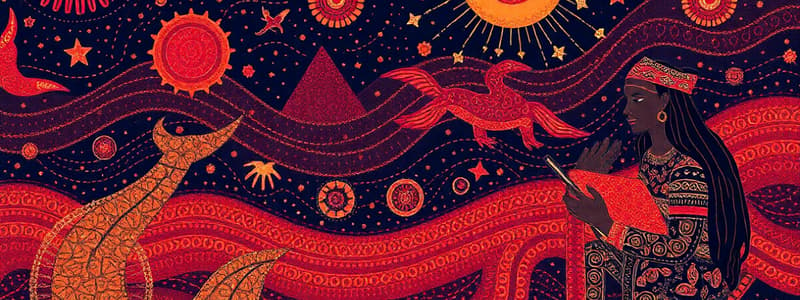Podcast
Questions and Answers
What does Indigenous research methodology primarily prioritize?
What does Indigenous research methodology primarily prioritize?
- Strict adherence to Western scientific standards
- Individual analysis of findings
- Collaboration and relationship-building (correct)
- Data collection through quantitative methods
Which research method emphasizes storytelling and interviews to understand Indigenous cultures?
Which research method emphasizes storytelling and interviews to understand Indigenous cultures?
- Qualitative research (correct)
- Both qualitative and quantitative research
- Quantitative research
- Experimental research
What is a key tenet of insurgent research methodology?
What is a key tenet of insurgent research methodology?
- To exclude Indigenous knowledge systems
- To align with colonial research frameworks
- To empower Indigenous communities (correct)
- To emphasize statistical data
What does the term 'tribal epistemology' refer to?
What does the term 'tribal epistemology' refer to?
In Indigenous contexts, ontology primarily concerns understanding what?
In Indigenous contexts, ontology primarily concerns understanding what?
What does axiology refer to in Indigenous epistemologies?
What does axiology refer to in Indigenous epistemologies?
Which term specifically refers to Indigenous peoples in Canada, excluding Métis and Inuit?
Which term specifically refers to Indigenous peoples in Canada, excluding Métis and Inuit?
What defines a distinct group of Indigenous people with mixed ancestry in Canada?
What defines a distinct group of Indigenous people with mixed ancestry in Canada?
What is the purpose of coppers in Northwest Coast cultures?
What is the purpose of coppers in Northwest Coast cultures?
Which theory suggests that the first inhabitants of the Americas migrated by following coastlines?
Which theory suggests that the first inhabitants of the Americas migrated by following coastlines?
What role do angakoks play in Indigenous Arctic communities?
What role do angakoks play in Indigenous Arctic communities?
What is characterized as a semi-subterranean home traditionally used by Indigenous peoples in cold regions?
What is characterized as a semi-subterranean home traditionally used by Indigenous peoples in cold regions?
Which theory posits that early humans known as the Clovis culture were the first to inhabit the Americas?
Which theory posits that early humans known as the Clovis culture were the first to inhabit the Americas?
What does the Kaianeraserakowa promote within the Haudenosaunee?
What does the Kaianeraserakowa promote within the Haudenosaunee?
When did humans migrate across the Bering Strait according to the Bering Strait Theory?
When did humans migrate across the Bering Strait according to the Bering Strait Theory?
What is the travois primarily used for?
What is the travois primarily used for?
What was the primary purpose of the Davin Report?
What was the primary purpose of the Davin Report?
Who primarily negotiated the Post-Confederation Land Treaties?
Who primarily negotiated the Post-Confederation Land Treaties?
What was the main effect of the Pre-Confederation Treaties?
What was the main effect of the Pre-Confederation Treaties?
During the War of 1812, which groups were primarily involved on the British side?
During the War of 1812, which groups were primarily involved on the British side?
What was a key characteristic of the Early British Land Treaties?
What was a key characteristic of the Early British Land Treaties?
When were the Numbered Treaties negotiated?
When were the Numbered Treaties negotiated?
What was the purpose of Métis Scrip?
What was the purpose of Métis Scrip?
Which region primarily experienced the signing of the Pre-Confederation Treaties?
Which region primarily experienced the signing of the Pre-Confederation Treaties?
What was the primary goal of the military and trade alliances formed between the French and Indigenous groups?
What was the primary goal of the military and trade alliances formed between the French and Indigenous groups?
What significant issue arose from the Jesuit Relations authored by French missionaries?
What significant issue arose from the Jesuit Relations authored by French missionaries?
Which Indigenous group did Samuel de Champlain form military alliances with to defend against the Iroquois?
Which Indigenous group did Samuel de Champlain form military alliances with to defend against the Iroquois?
What does Bill C-31 address in relation to Indigenous peoples in Canada?
What does Bill C-31 address in relation to Indigenous peoples in Canada?
What was a common consequence of enfranchisement policies for Indigenous peoples?
What was a common consequence of enfranchisement policies for Indigenous peoples?
Which role likely pertains to John Brandt in the context of Indigenous or colonial history?
Which role likely pertains to John Brandt in the context of Indigenous or colonial history?
What was a common practice regarding Indigenous peoples in New France, particularly in relation to the fur trade?
What was a common practice regarding Indigenous peoples in New France, particularly in relation to the fur trade?
Who was Tecumseh and what notable aspect is he recognized for?
Who was Tecumseh and what notable aspect is he recognized for?
What is a key role of Métis women in the fur trade?
What is a key role of Métis women in the fur trade?
Why is referring to the Métis as 'mixed' problematic?
Why is referring to the Métis as 'mixed' problematic?
What does the term 'Two-Row Wampum' symbolize?
What does the term 'Two-Row Wampum' symbolize?
What does 'Bimaadiziwin' emphasize in Anishinaabe philosophy?
What does 'Bimaadiziwin' emphasize in Anishinaabe philosophy?
What is the significance of Treaty Rights?
What is the significance of Treaty Rights?
What is meant by Treaty Adhesion?
What is meant by Treaty Adhesion?
Which of the following statements is true regarding the British North America Act?
Which of the following statements is true regarding the British North America Act?
What role did Métis women play in cultural exchange?
What role did Métis women play in cultural exchange?
What was one of the primary goals of the residential school system?
What was one of the primary goals of the residential school system?
What concept from the Diné (Navajo) worldview emphasizes resilience through adversity?
What concept from the Diné (Navajo) worldview emphasizes resilience through adversity?
Which legislation was primarily aimed at the assimilation of Indigenous peoples in Canada?
Which legislation was primarily aimed at the assimilation of Indigenous peoples in Canada?
What was a significant issue debated regarding parental access to children in residential schools?
What was a significant issue debated regarding parental access to children in residential schools?
How did Inuit and Métis children's experiences in residential schools differ from First Nations children?
How did Inuit and Métis children's experiences in residential schools differ from First Nations children?
What day recognizes the contributions of Indigenous peoples in military service?
What day recognizes the contributions of Indigenous peoples in military service?
Who was Tommy Prince and what is he known for?
Who was Tommy Prince and what is he known for?
What does the term 'Sixties Scoop' refer to?
What does the term 'Sixties Scoop' refer to?
Flashcards
Kelp Forest
Kelp Forest
Underwater forests found in coastal areas, mostly along the Pacific Coast. They are important to many Indigenous cultures for food, tools, and medicine.
Beringia
Beringia
A land bridge connecting Asia and North America during the Ice Age. It's believed to be the route by which the ancestors of Native Americans migrated.
Angakoks (Shaman)
Angakoks (Shaman)
Spiritual healers or leaders in many Indigenous Arctic communities. They guide people through spiritual practices and healing.
Coppers
Coppers
Signup and view all the flashcards
Kaianeraserakowa (Great Law of Peace)
Kaianeraserakowa (Great Law of Peace)
Signup and view all the flashcards
Travois
Travois
Signup and view all the flashcards
Pit Houses
Pit Houses
Signup and view all the flashcards
Coastal Migration Theory
Coastal Migration Theory
Signup and view all the flashcards
Indigenous Research Methods
Indigenous Research Methods
Signup and view all the flashcards
Indigenous Methodologies
Indigenous Methodologies
Signup and view all the flashcards
Insurgent Research Methodology
Insurgent Research Methodology
Signup and view all the flashcards
Tribal Epistemology
Tribal Epistemology
Signup and view all the flashcards
Ontology in Indigenous Contexts
Ontology in Indigenous Contexts
Signup and view all the flashcards
Axiology in Indigenous Contexts
Axiology in Indigenous Contexts
Signup and view all the flashcards
First Nations
First Nations
Signup and view all the flashcards
Métis
Métis
Signup and view all the flashcards
Davin Report
Davin Report
Signup and view all the flashcards
Pre-Confederation Treaties
Pre-Confederation Treaties
Signup and view all the flashcards
Early British Land Treaties
Early British Land Treaties
Signup and view all the flashcards
Post-Confederation Land Treaties
Post-Confederation Land Treaties
Signup and view all the flashcards
War of 1812
War of 1812
Signup and view all the flashcards
Métis Scrip
Métis Scrip
Signup and view all the flashcards
Numbered Treaties
Numbered Treaties
Signup and view all the flashcards
Red River Rebellion
Red River Rebellion
Signup and view all the flashcards
Treaty Right
Treaty Right
Signup and view all the flashcards
Treaty Adhesion
Treaty Adhesion
Signup and view all the flashcards
Two-Row Wampum
Two-Row Wampum
Signup and view all the flashcards
Kiciwamanawak
Kiciwamanawak
Signup and view all the flashcards
Bimaadiziwin
Bimaadiziwin
Signup and view all the flashcards
Gdoo-naaganina
Gdoo-naaganina
Signup and view all the flashcards
British North America Act
British North America Act
Signup and view all the flashcards
Métis Identity
Métis Identity
Signup and view all the flashcards
French-Indigenous Alliances
French-Indigenous Alliances
Signup and view all the flashcards
Jesuit Relations
Jesuit Relations
Signup and view all the flashcards
French Slavery of Indigenous Peoples
French Slavery of Indigenous Peoples
Signup and view all the flashcards
Champlain's Military Alliances
Champlain's Military Alliances
Signup and view all the flashcards
Bill C-31
Bill C-31
Signup and view all the flashcards
Enfranchisement
Enfranchisement
Signup and view all the flashcards
Tecumseh
Tecumseh
Signup and view all the flashcards
Wabasha (or similar)
Wabasha (or similar)
Signup and view all the flashcards
Forced Assimilation
Forced Assimilation
Signup and view all the flashcards
Residential Schools
Residential Schools
Signup and view all the flashcards
Gradual Civilization Act (1857)
Gradual Civilization Act (1857)
Signup and view all the flashcards
Indian Act (1876)
Indian Act (1876)
Signup and view all the flashcards
Dinjii Zhuh
Dinjii Zhuh
Signup and view all the flashcards
Métis & Inuit in Residential Schools
Métis & Inuit in Residential Schools
Signup and view all the flashcards
Tommy Prince
Tommy Prince
Signup and view all the flashcards
Indigenous Veterans Day
Indigenous Veterans Day
Signup and view all the flashcards
Study Notes
Indigenous Studies Overview
- Indigenous research methods emphasize integration of Indigenous ways of knowing and doing, such as community engagement, oral traditions, and participatory action.
- Indigenous methodologies prioritize collaboration, relationship-building, and decolonization, contrasting with traditional Western research methods.
- Qualitative research focuses on understanding experiences, cultures, and lives of Indigenous peoples through interviews, storytelling, etc.
- Quantitative research uses numbers and statistics (e.g., land use, health disparities, demographics) within Indigenous communities.
- Insurgent Research Methodology challenges colonial research frameworks, focusing on Indigenous community empowerment.
- Tribal Epistemology represents Indigenous knowledge systems, encompassing spiritual beliefs, oral histories, traditions, and community-specific worldviews.
- Ontology, specifically within Indigenous contexts, relates being and existence interconnected with nature, community, and spirituality.
- Axiology refers to Indigenous values and ethics, with respect for all life, reciprocity, and communal well-being.
- Indigenous describes original inhabitants of a region with specific cultural, historical, and spiritual ties to the land.
- First Nations represent Indigenous peoples in Canada (excluding Métis or Inuit), with diverse cultures, languages, and histories.
- Métis are a distinct Indigenous group with mixed European-Indigenous ancestry, language (Michif), and cultural practices.
- Inuit are Indigenous peoples of the Arctic regions of Canada, Greenland, and Alaska.
- Aboriginal is a collective term for Indigenous peoples of Canada including First Nations, Métis, and Inuit.
- Native American describes Indigenous peoples of the United States, including various tribes and nations.
- Kelp forests hold significant importance in many Indigenous cultures particularly along the Pacific Coast for food, tools, and medicines.
- Beringia was a land bridge connecting Asia and North America during the Ice Age, often believed to be the migratory route for ancestors of Native Americans.
- Angakoks are spiritual healers or leaders within many Indigenous Arctic communities.
- Coppers were used in Northwest Coast cultures as symbols of wealth, status or ceremony.
- Kaianeraserakowa (Great Law of Peace) is a constitution followed by the Haudenosaunee to promote peace, unity and governance.
- Travois are a frame used to transport goods and tools historically used by Indigenous peoples in the Plains region, often attached to horses or dogs.
- Pit Houses are semi-subterranean homes traditionally used by Indigenous peoples in cold regions for insulation.
Perspectives on First Contact with Europeans
- Potlatch is a gift-giving feast practiced by Indigenous peoples of the Pacific Northwest, demonstrating wealth, social status, and social ties.
- Great Law of Peace is the constitution of the Haudenosaunee Confederacy, emphasizing peace, unity, and governance.
- Many Lodges Gathering describes indigenous gatherings symbolizing unity and shared customs.
- Thule Period (circa 1000-1600 CE) marked development of Inuit culture and traditions in the Arctic.
- People of the Dawn is a term for early Indigenous peoples in the northeastern Americas.
Indigenous-Colonial Wars
- Beaver War Thesis suggests Indigenous wars were driven mainly by fur trade competition.
- Pemoussa is a term for a significant historical or cultural figure in Indigenous communities.
Government Policy Period: French/British to Canadian Indian Policy
- Bill C-31 addressed discrimination in the Indian Act regarding gender and enfranchisement.
The Métis Period: Métis Identity, Repression & Resistance
- Section 31/32 of the Manitoba Act outlines rights for Métis families after their presence in Manitoba lands.
- "Logic of Elimination" refers to a colonial policy aimed at erasing Indigenous cultures, identities and societies.
- Métis are a distinct Indigenous group with mixed European and Indigenous ancestry, language (Michif) and history.
- Powley Test is a legal test used to determine Métis rights to hunt and fish in traditional territories.
- Capote is a traditional Métis fur-trading coat.
- Métis flag represents the unity of Métis people.
Land Dispossession: Treaties & Scrip
- Treaty Right is a right established through an Indigenous and government agreement for access to land, hunting, and fishing.
- Treaty Adhesion outlines the process of joining an existing treaty by an Indigenous group.
- Two-Row Wampum represents a peaceful coexistence agreement between the Haudenosaunee and European settlers.
Residential School Period, History & Reflections of First Nations, Métis & Inuit
- Pass System restricted Indigenous movement.
- Chief Shingwauk was an important Anishinaabe leader and advocate for Indigenous rights, particularly in relation to education.
WW1 & WW2 Indigenous Involvement
- Charlotte Edith Monture and Mary Greyeyes were notable Indigenous women who served in the military during World Wars I and II.
- Forgotten Soldiers represents Indigenous veterans who were often overlooked during World Wars I and II.
- Bill C-51 was a Canadian law that made it illegal for Indigenous peoples to participate in activities deemed subversive to the Canadian government.
Little Ice Age
- Little Ice Age was a period of cooler temperatures that affected agricultural practices and the environment for Indigenous peoples in northern regions.
Northwest Resistance
- Northwest Resistance (1885) refers to the resistance of Métis and First Nation groups led by Louis Riel against the Canadian government's treatment of Indigenous peoples.
Studying That Suits You
Use AI to generate personalized quizzes and flashcards to suit your learning preferences.




